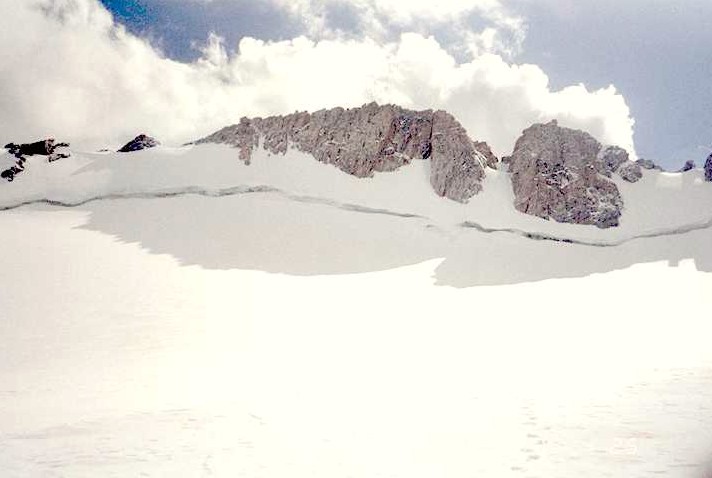- Upper Fremont Glacier
Infobox_Glacier | glacier_name = Upper Fremont Glacier

caption = Upper Fremont Glacier on the north ridge of Fremont Peak
type = Mountain glacier
location =Wyoming , U.S.
coordinates = coord|43|07|45|N|109|36|57|W|type:glacier_region:US-WY|display=inline,title
area = 690 acres (279 ha) (in 1990)
length = 1.35 miles (2.2 km)
thickness = 538 feet (164 m) (in 1998)
terminus = Moraines
status =Upper Fremont Glacier is located in the
Fitzpatrick Wilderness ofShoshone National Forest in theU.S. state ofWyoming . [cite web | last = TopoQuest | first = | authorlink = | coauthors = | year = | url = http://www.topoquest.com/map.asp?z=12&n=4776116&e=612636&size=l&u=7&datum=nad83 | title = Upper Fremont Glacier, USGS Fremont Peak North (WY) Topo Map | format = map | work = | accessdate = 2008-07-04] ThisWind River Range glacier is associated with the largest grouping of glaciers in the U.S.Rocky Mountain s and lies on the north slope of Fremont Peak, the third tallest mountain in Wyoming. Upper Fremont Glacier is at an average altitude of 13,450 feet (4,100 m) and is one the highest altitude glaciers in the American Rockies.cite web | last = Reddy | first = Michael | authorlink = | coauthors = | year = | url = http://wwwbrr.cr.usgs.gov/projects/SW_corrosion/idahoice/fremont.html | title = Upper Fremont Glacier | format = | work = | publisher = U.S. Geological Survey | accessdate = 2007-03-30]Ice core samples were taken from Upper Fremont Glacier in 1990-1991. These ice cores were analyzed for climatic changes as well as alterations of atmospheric chemicals. In 1998 an unbroken ice core sample of 538 feet (164 m) was taken from the glacier and subsequent analysis of the ice showed an abrupt change in the oxygen isotope ratiooxygen-18 to oxygen-16 in conjunction with what is widely regarded as the end of theLittle Ice Age , a period of cooler global temperatures between the years 1550 and 1850. A linkage was established with a similar ice core study which had been undertaken on theQuelccaya Ice Cap inPeru , which also demonstrated the same changes in the oxygen isotope ratio during the same period. The climatic implications from the ice cores taken from both sites support evidence of a sudden global climate change during the mid 19th century.cite web | last = Reddy | first = M.M. | authorlink = | coauthors = D.L. Naftz, P.F. Schuster | year = | url = http://wwwbrr.cr.usgs.gov/projects/SW_corrosion/icecore/ | title = Ice-Core Evidence of Rapid Climate Shift during the Termination of the Little Ice Age | format = | work = | publisher = U.S. Geological Survey | accessdate = 2007-03-30]Ice cores from the glacier also showed increased levels of
Tritium (³H) andchlorine -36 around the year 1963, which coincides with the peak period of above groundnuclear testing .The same ice cores were also tested for Mercury deposition from natural and human-induced activities. This is the first known instance in which ice cores have been used to determine Mercury deposition from a mid-latitude glacier in
North America , as all previous studies have been derived from other sources.cite web | last = Krabbenhoft | first = David | authorlink = | coauthors = Paul Schuster | year = | url = http://toxics.usgs.gov/pubs/FS-051-02/pdf/fs-051-02.pdf | title = Glacial Ice Cores Reveal A Record of Natural and Anthropogenic Atmospheric Mercury Deposition for the Last 270 Years | format = pdf | work = USGS Fact Sheet FS-051-02 | publisher = U.S. Geological Survey | accessdate = 2007-03-30] The majority of Mercury deposition is by way of the atmosphere and sources of the element may be from volcanic activity or from industrialization, but volcanoes contribute a small proportion of the Mercury. The ice core samples from the Upper Fremont Glacier indicated that levels of Mercury increased dramatically during theindustrial revolution and have decreased significantly since the mid 1980s. It is believed that the decrease in Mercury deposition since the 1980s coincides with the passage of theClean Air Act .Cited references
ee also
*
List of glaciers
Wikimedia Foundation. 2010.
